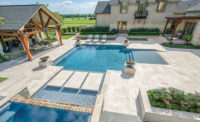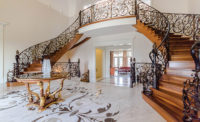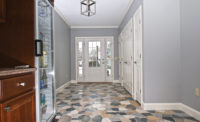Tile trends are constantly evolving. New colorways, patterns, textures and formats are being introduced each year, which give designers more inspiration and motivation to utilize tile products in their projects. Tile manufacturers are also working hard to craft innovative, unique designs to cater to every type of space.
We had the chance to sit down with a handful of designers and creative directors, who shed some light on the current trends that are dominating the tile market. Designers include Ariana Lovato, owner and principal designer at Honeycomb Home Design, LLC in Pismo Beach, CA; Lisa Mende, principal of Lisa Mende Design in Charlotte, NC; Phillip Dockery, managing director at Eric Cohler Design in New York, NY; and Jennifer Stoner, owner of Jennifer Stoner Interiors in Richmond, VA. Tile design professionals include Katie Michael-Battaglia, design director at Nemo Tile + Stone in New York, NY; and Emily Holle, creative director at M S International, Inc. (MSI) in Orange, CA, who is responsible for trend and design direction at the company.
“We are seeing more people experiment with shapes and textures, especially when it comes to wall tiles,” Michael-Battaglia said. “Customers are continually interested in a classic stone aesthetic. We have had the porcelain tiles that replicate stone and marble of the more popular stones such as Carrara, Calacatta, Statuario and Nero Marquina. Currently though, there has been an explosion of porcelain tiles replicating many types of stones, specifically semi-precious stones.
“Another trend that has been around for a while but is still very current is wood-based tile styles that mimic the natural look and feel of real wood,” she went on to say. “Factories are now advancing this style and playing with different variations and shapes. There’s the standard plank and now there are more shapes like hexagons and chevrons. People are also continuing to place wood looks in contrast with stone.”
Holle agreed with Michael-Battaglia, as she has also seen the surge in textures, and wood-look and stone-look tiles, which she has coined the “modern farmhouse” trend for 2020. “Black stone fireplaces. Reclaimed barn doors. Wood beams. Everything in the modern farmhouse feels comfortable, yet stylish,” Holle explained. “The flush-with-texture cozy vibe is made all the more dreamy with natural wood tones, a black and white palette, and brushed brass accents.”
As far as colors are concerned, both women have seen different shades of blue dominating the market, along with neutrals, which will always remain classic choices. “From Arctic lights and cerulean to slate, indigo and graphite, the blue family dominates design this year in all the right ways,” Holle said. “Navy kitchen islands look inspired and bold. Blue-gray natural stones, quartz and subway tile bathe backsplashes, walls and countertops in a fresh, soothing light. Shimmering sea glass stone mosaics — in patterns of every shape and size — bring the ocean to showers, laundry rooms and pools. For devotees around the world, this day dreamy color story delivers calm and a pop of mystery indoors and out.”
“Colored tiles have always been around, but in the last couple of years there has been more of an interest in using colored tiles in projects across industry categories,” Michael-Battaglia added. “On the other hand, the Northeast has been known to stay true to cool neutral colors like gray, black and white. The most popular color outside of neutrals is light blue, as it’s the easiest and most versatile color to digest. When people think about tile, they think they have to be safe because it lasts longer than paint, carpet or wood. In addition to light blue, people have shown interest in mint greens, as well as the warmer pink, blush or terracotta palette.
“That said, color usage varies by region,” she went on to explain. “Beige, for example, is used abundantly in homes down south and in coastal areas, while it lacks popularity in the Northeast. Warmer climates and coastal locations tend to have tile applications in more spaces in the home, including rooms outside of the kitchen and bathroom, because it feels cooler than a carpet or wood and is easier to clean, particularly for homes near the beach.”
As wood- and stone-look tiles continue to flourish, more designers and customers are opting for these designs for flooring, walls and even accents. “The most popular designs are always going to be the classic stone looks like Carrara, Nero Marquina and Statuario, but semi-precious stones like onyx and manmade terrazzo have become more fashionable in recent years,” Michael-Battaglia said. “We are seeing variations on replications of onyx as an option for porcelain tiles and terrazzo looks in both classic styles and larger aggregate variations. Terrazzo has always been a classic, tried-and-true choice in commercial spaces. The fabric look is still there, it just isn’t as prevalent as it has been in past years. Raffia is one of our most popular lines, which provides that look. It’s still very popular, but you don't see people (factories) making more variations of those. They’re still relevant and people want them, but not as classic as a stone look would be.”
“The 2020 color story is awash with all things warm, soft and light,” Holle added. “A decidedly tastier forecast, bevies of blondes, creams and warm wood tones lend a sophisticated California vibe to interiors. Modern simplicity at its finest, golden-veined white quartz and creamy quartzites are on the rise, especially when paired with blonde, sun-kissed wood grain planks.”
With the seemingly endless variety of tile options out there today, it may be overwhelming to decide on which types to use when designing a particular space or an entire home. However, if Michael-Battaglia has learned one thing from dealing with clients all over the U.S., it’s that the types of tile designs that are used are dependent on the space in which they’re implemented. “While design choices are always dependent on the desires of the client, the shape and function of the space being designed will dictate what makes the final cut,” she said. “Since bathrooms have a smaller footprint, for example, people have found it to be a great space to experiment and get a little playful with patterns and mosaics. This would also apply to smaller spaces such as a mudroom. More often, we see patterns on the floor and the use of a neutral tile like a subway or textured subway-like tile.
“When it comes to the kitchen, we see clients taking the safer route, as they’re particularly concerned with resale value and trends going out of style,” she went on to explain. “Depending on the size of the kitchen, using larger-format tiles for the floors is more popular. You’re not going to be seeing a lot of mosaics used in this space. For backsplashes, some people like the large-format style because there is less grout and it’s easier to clean, especially near the stove. That being said, there are also the clients that do want to have a mosaic as a backsplash that can bring color or visual texture to the space. Any place that needs cleanability and a sense of permanence would impact the style selected.”
The designer’s perspective
For designers and architects, it’s important to be educated on the current trends in order to provide their clients with the most up-to-date information and guidance. Ariana Lovato of Honeycomb Home Design LLC in Pismo Beach, CA, who regularly utilizes porcelain and ceramic tile in her projects, particularly enjoys the textured tiles that have been trending for the last couple of years. “I’ve been seeing a lot of texture on ceramic wall tiles and I am here for it,” she said. “Textured walls that emulate grasscloth, wicker, branches and leaves are making a statement right now. Patterned tile that looks like fabric is also a big trend and can totally work in the right setting. The design industry as a whole is going away from the gray-black-white theme and welcoming the warm tones again, and I think it’s a great move.”
Phillip Dockery of Eric Cohler Design in New York, NY, piggybacked Lovato’s comments, adding how he is also seeing the tone-on-tone trend. “This is being done in porcelain, ceramic, glass and natural stone. Texture, texture, texture is what it’s all about,” he said. “Another great trend is the implementation of metal accent inlays on vertical surfaces. Metal inlay products from companies such as Schluter have long been used in flooring installations as a transition strip between materials, but also as an accent piece. Now, designers are using beautiful tones of gold, silver and bronze to add patterns and interest to walls in both residential and commercial spaces.”
For Lisa Mende of Lisa Mende Design in Charlotte, NC, and Jennifer Stoner of Jennifer Stoner Interiors in Richmond, VA, detailed patterns are really standing out. “There are so many interesting patterns in the market currently,” Mende said. “I like the large-scale murals we are seeing, which are being offered across the board in wallpaper, fabrics and tile. To create a mural wall with one of these products, especially in tile, adds such an artisan quality to a room.
“When I was at Cevisama in Valencia, Spain, in February, I saw tile that mimicked other materials such as wood and fabric, and even designs that look like woven materials,” she went on to say. “The Persian-inspired trend is strong, therefore, there were also tiles that looked like antique rugs, which was interesting. Cevisama was an eye-opener for me. I was so inspired by what I saw there that I’m anxious to incorporate some of the new designs into client’s projects.”
“At Cevisama, it was great to see so much color and pattern being introduced,” Stoner added. “The encaustic tile trend has been a big Pinterest-driven force in the U.S. for a few years, but it was great to see more abstract and painterly patterns on ceramic. These tiles inspire me to create feature walls in more areas of the house.
“There were also several [tiles] that mimicked fabrics and weaves,” she went on to say. “The linen look has been around for a while, but the woven tile from Aparici was great. It looked like a woven jute rug.”
While these designers utilize a lot of tile in their residential and commercial projects, natural stone is still a huge draw for some clients because of its natural beauty and the timeless aesthetic it provides. “From an aesthetic point to an economic point (from not having to replace ‘trendy’ ‘fashion’ material to resale value) to an environmental (not filling landfills with materials caused by multiple renovations) point, we strive to create spaces that excite today and for years to come,” Dockery said. “Because of each of these factors, we do tend to lead with natural stone as much as possible. It is our point of view that by choosing natural products with natural tones, we are freed from annual predictions of what’s hot and what’s not. We feel that these ‘hot’ colors are better implemented in soft goods rather than higher ticket items such as stone and tile. Although our clients typically only want to use natural stone, I do believe the stone-inspired tile products have come a long way recently and I do believe this trend could change.”
“We’ve had a big push from clients for natural stone over the past several years, especially in their master bathrooms and kitchen backsplashes,” Stoner said. “We do, however, incorporate more fun patterns in ceramic or porcelain in other rooms of the house such as guest bathrooms, laundry rooms and mudrooms.”
Although natural stone reigns supreme in some areas of the country and world, stone-inspired tiles are offering good competition for their natural stone counterparts, especially in coastal areas.
“Where clients are willing to splurge in their master bathrooms for natural stone, they often elect a good faux marble in their secondary bathrooms,” Stoner said. “Thankfully, the faux marbles have continued to improve over the years and now there are plenty of really gorgeous options.”
“Since most of our work is residential and our demographic is young families, we use a lot of ceramic tiles that are modeled after natural stone,” Lovato said. “The durability and price is usually what drives that decision, but we work hard to make sure the space feels cohesive and reflects their aesthetic taste and of the architecture of the home. Since our studio is based in a coastal region, we do a lot of houses with all-tile flooring.”
“It totally depends on the project, but we are seeing more clients using stone counterparts and definitely more tile in projects,” Mende added. “Homeowners like the durability that tile offers for high-traffic areas.”
As tile products continue to advance and push design boundaries, more design professionals are inclined to utilize them for renovations and new construction. “I feel like we’re using more tile in our projects, but the push is coming from our end, not the clients,” Stoner said. “We’re lucky to be exposed to so many beautiful options and I feel like it’s the designer’s job to introduce tile as an alternative to a traditional wall covering.”









